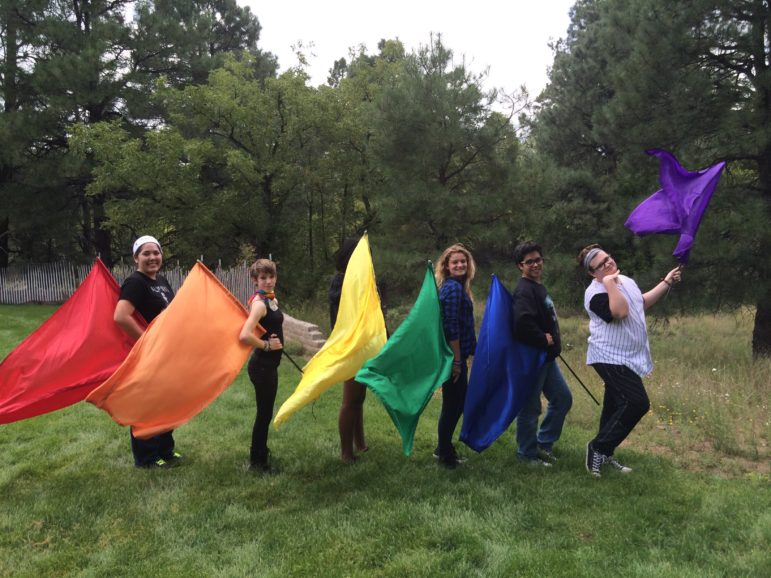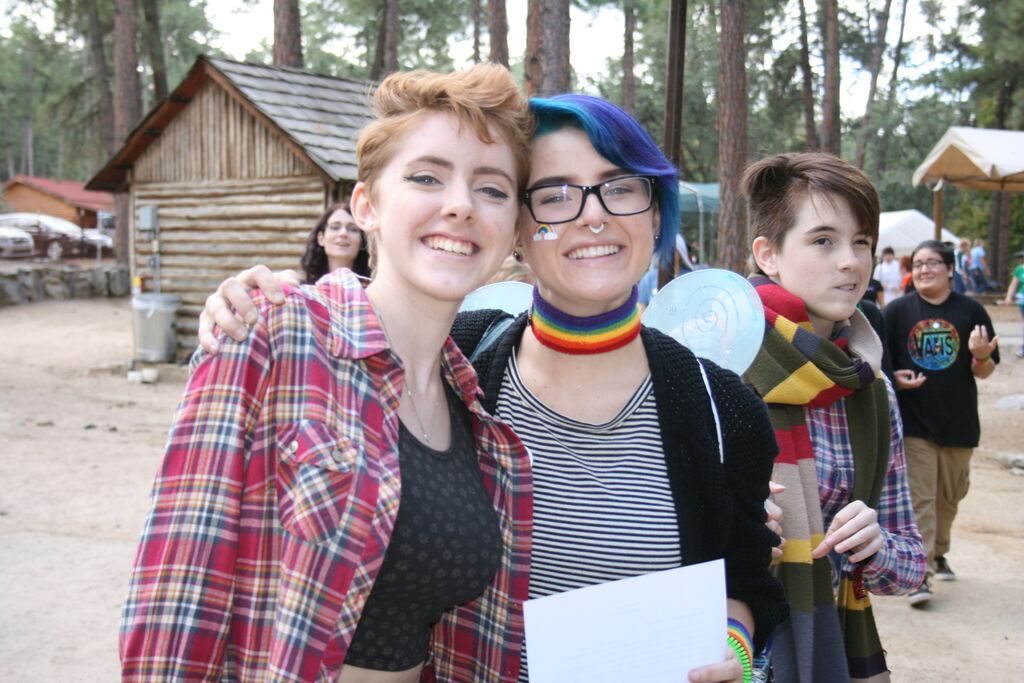When kids from the after-school program at Garfield and Lincoln elementary schools in Corvallis, Oregon, walked into the nearby Osborn Aquatic Center, they had some questions.
Why do you put chemicals into the pool?
An employee of the aquatic center explained what the chemicals are, how they keep the pool clean and how they maintain the ph of the water.
It was part of the Science in the Neighborhood project at the after-school STEM club for third- to fifth-graders at the two schools, both Title I schools with a large Latino population.
The goal of the club is to bring Latino youth into STEM programs and enhance their interest, but also to widen the experience of teachers in training at Oregon State University. By working with the club, student teachers gain knowledge of cultural and linguistic differences.
“The kids drive the content with their questions,” said Ana Lucia Fonseca, a member of the Oregon State University Extension Service faculty and the FIESTA collaboration, which runs the club.
Kids visit gardens, grocery stores other neighborhood businesses and organizations.
The framework “creates an expectation for cultural competence, making children’s cultural practices the basis of scientific learning…” Fonseca wrote in the journal Afterschool Matters, along with co-authors.
At the local Trader Joe’s grocery store, kids looked at prices of bread, milk and other products. They added up the item, trying to keep within a budget.
“We were doing math,” Fonseca said.
In another project sparked by kids’ interests, “we built a tortilla press … and looked at the physics of it,” she said.
The program is structured to tap into the knowledge the children bring from their own background and experience.
“We interview families and try to find out what is science for them,” Fonseca said.
“We find the science in an everyday action,” she said. “We try to put children in expert positions.” They see that science is not limited to a lab, but is part of everyday life.
The importance of cultural competency
Cultural competency is among the core competencies for youth development professionals listed by the National Afterschool Association.
It requires being aware of one’s own cultural beliefs and practices, according to the NAA, and it means valuing and respecting the culture of others. It also means creating an inclusive, welcoming and respectful environment for all children, connecting teaching and learning opportunities to the the kids’ experience and cultures.
Several states, including Washington and Arizona, have extended beyond the NAA’s listing to make cultural responsiveness one of their quality standards.
“To make progress with real youth outcomes” you’ve got to get staff to be responsive to the cultures of the children in the program, said Jackie Jainga-Hyllseth, chief program quality officer at School’s Out Washington, the state’s after-school network.
If you don’t train staff to be culturally responsive, how can you create a safe environment for kids to realize their potential, she asks.
When teachers and after-school staff are mostly white and female, they may have little exposure to the different stresses on people of other cultures and their different cultural practices, Jainga-Hyllseth said. The staff could be running a program for English language learners or children of color, she said.
If they have no experience or knowledge or awareness of the children’s different culture, race or physical disability, it’s hard for them to understand how to provide a safe environment, she said.
Data shows the major achievement gap between white youth and young people of color.
“We lead with race because that’s the most urgent area that needs attention and because we have data that show the enormity of the gap between African-American children and white children in school, in health and in their environment,” she said.
Cultural competence is needed by both individuals and programs, Jainga-Hyllseth said. Programs should develop policies to create space for youth to explore their own identities, including cultural beliefs and practices, according to the Washington standards. They should recruit qualified staff who represent the culture and diversity of the children who are served.
Access for all youth
More than a decade ago, the Forum for Youth Investment discussed the problem of access to after-school programs for kids of color. The Forum issue a brief “After-School for All: Exploring Access and Equity in After-School Programs,” noting that English-language learners, youth with disabilities and LGBTQ youth seemed to be particularly underserved.
In a 2013 brief, the Afterschool Alliance reported that African-American and Latino kids are more than twice as likely to live in low-income families, and their unmet demand for after-school services is higher than for white families.
In addition, children with disabilities have far less opportunity to take part in after-school activities than children without disabilities, according to KIT (Kids Included Together) a Washington, D.C.-based nonprofit that trains community organization on how to be inclusive.
According to the National Center for Education Statistics, 13 percent of children in American public school receive special education services because of a disability or particular need.
A large challenge for LGBT youth is social ostracism, according to the 2012 Human Rights Campaign report “Growing Up LGBT in America,” a survey of 10,000 youth. LGBT kids are two times more likely than non-LGBT kids to report verbal or physical harassment and exclusion by their peers. One-third said they had no adult with whom to discuss personal problems.
All kids? Really?

Photo courtesy of One.N.Ten
Young people express pride in themselves at one.n.ten, a Phoenix nonprofit that serves LGBT youth. Adults who work with kids should increase their own understanding of cultural diversity in order to help all young
The Arizona after-school network didn’t beat around the bush when it added cultural competence to its quality standards.
“We are very, very specific that we want youth to thrive regardless of race, color, religion, sex, income level, national origin, physical, mental and learning ability, sexual orientation, or gender identity and expression,” said Courtney Sullivan, executive director of the Arizona Center for Afterschool Excellence.
This standard, along with a standard for youth engagement, prompted a rush of questions from after-school providers, she said.
“They have been the biggest topics of conversation.” Sullivan said, noting that programs struggle in these areas, and these are the standards that cause the most anxiety among after-school providers.
Providers may have sponsoring organizations whose guidelines clash with the statewide quality standards.
For example, some may not be able to do any programming that deals with sexual orientation, she said, because they have to be sensitive to their sponsoring organization’s guidelines.
Programs may be run by schools, faith-based organizations or other groups.
But a conversation has been created around the issues, Sullivan said, and that’s good.
Like many state-afterschool networks, the Arizona Center for Afterschool Excellence has a network of trainers.
Providers can assess themselves with a tool that scores their strengths in meeting the standard. They are then provided with resources that can aid in improvement, including training and an improvement plan.
“It’s not an easy or perfect process,” Jainga-Hyllseth said.
“[But] we’re looking at system change,” she said.
A range of ability: Working with kids who have disabilities
In 1995, Mary Shea created a pilot program at the Jewish Community Center in San Diego to include children with disabilities in a summer camp serving 500 children.
“It was transformative,” she said. “It was a significant cultural shift.”
Many out-of-school time programs may be concerned about how to accommodate children who have different abilities, which can range from kids who are blind to those who have cerebral palsy or autism. to make their programs inclusive, “they face the fear factor,” she said.
Shea co-founded Kids Included Together (KIT), a nonprofit that trains community based-organizations how to be inclusive.
Programs often designate an “inclusion facilitator,” she said, who does intake and is the point person for communication with the child’s family. The inclusion facilitator helps the child integrate into the program and then steps back.
Youth workers learn to be better observers of children. The goal is to make respectful accommodations based on what each individual child needs.
“Every single child has gifts and abilities, and it is our job not to label,” Shea said.
“You need to evaluate what the child needs at this point in time, in this environment, with this activity and with these adult-child ratios,” she said.
One of the big barriers for youth worker is fear, Shea said, but when youth workers get training
Set up an environment that supports good behavior, she said. Up to 90 percent of the challenge is children’s behavior, she said.
Full inclusion improves academic performance and engagement, and has a positive impact on attitude and behavior, according to the Afterschool Alliance in a February 2014 issue brief. Kids develop friendships and make advances in communication and social skills, according to the Alliance.
“There are so many kids who have been marginalized,” Shea said. Becoming inclusive can help all young people thrive.
Acknowledging gender fluidity
At a youth center in downtown Phoenix, Arizona, teens can be found taking cooking lessons, participating in a drum circle or doing martial arts. They can take part in a queer support group or a trans support group and get health-care services.
The center is run by one.n.ten, a nonprofit organization that serves lesbian, gay, bisexual, transgender and questioning (LGBTQ) youth ages 14 to 24.
Twelve guidelines keep the space safe and welcoming. Keep confidences, avoid labels and respect personal opinions are among them.
Youth programs should always set up safe space guidelines that are appropriate for their program, said Rachel Sherman, program coordinator at one.n.ten.
Most youth workers “are dedicated to the mental, physical and emotional health of the youth they serve,” she said.
“[But] the majority of people don’t have the knowledge they need to appropriately work with LGBTQ people,” Sherman said. They may assume that others have a straight lifestyle. These “microaggressions” are small assumptions “that bite at individuals,” Sherman said.
Sherman’s recommendations:
- De-gender your language and be more inclusive. When the staff talks to kids, leave ample room for kids to share their gender identity.
- Ask young people: “What’s your pronoun?”
- Avoid making assumptions. Avoid asking about someone’s boyfriend or girlfriend. Instead, ask about their “love interest.”
- When you introduce yourself, indicate which pronouns you prefer.
- Understand the difference between gender identity and gender expression. “Gender identity is not necessarily tied to how you dress, move or speak in the world. It’s not tied to sexual orientation or the gender assigned at birth,” Sherman said.
“Adults often want to put things in boxes,” Sherman said. “Understand that all of these notions are fluid,” she said. “Young people can shift and move.”
They are not willing to put themselves in a box but are comfortable in being able to express themselves, she said.
For additional resources and strategies on working with linguistically and culturally diverse students, go to Language and Literacy in the Out-of-School Time Research and Resource Hub.
This story has been updated.































